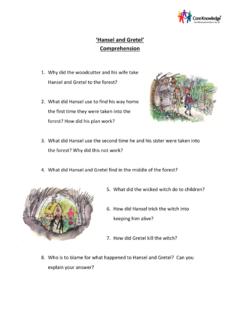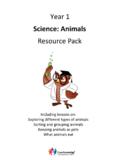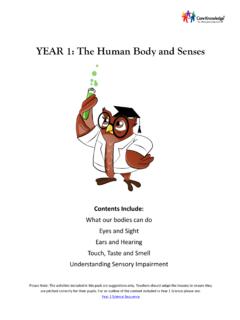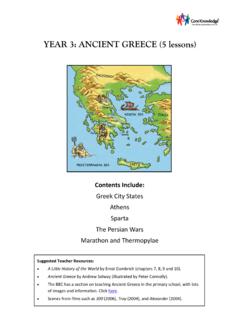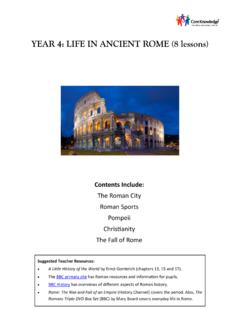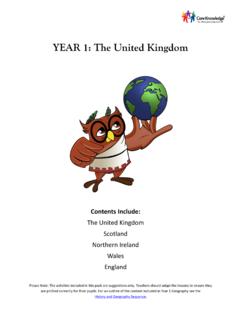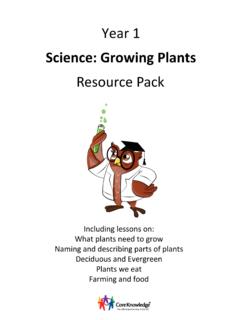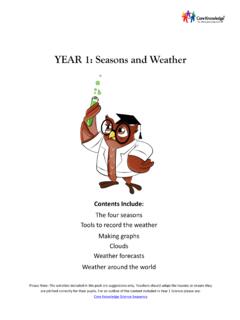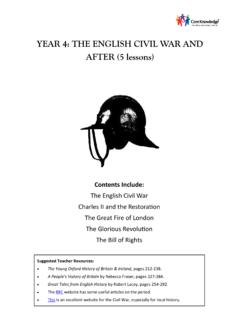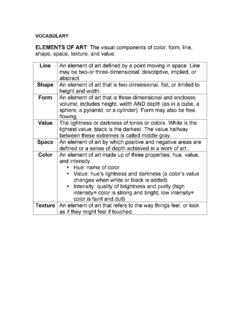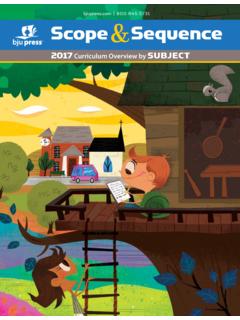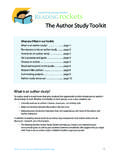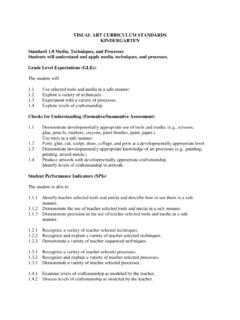Transcription of YEAR 1: Elements of Art: Colour - Core Knowledge UK
1 year 1: Elements of Art: Colour Contents Include: Primary and Secondary Colours Warm and Cool Colours A Study of a Famous Artist Please Note: The activities included in this pack are suggestions only. Teachers should adapt the lessons to ensure they are pitched correctly for their pupils. For an outline of the content included in year 1 Visual Arts, see the Visual Arts Sequence. Lesson 1: Introduction to Colour This lesson should be used to establish what the children know about Colour . Children will learn the three primary colours (yellow, red and blue) and will begin to explore Colour mixing.
2 By the end of this lesson, children should be able to name the three primary colours and should have some ideas about how to mix primary colours to make various secondary colours, for example, mixing red and yellow to make orange. The colours red, yellow and blue are called primary colours in art because they cannot be made by mixing together any other colours. When two primary colours are mixed together, the Colour created is called a secondary Colour . In art, some colours can be used to create feelings of warmth ( red, yellow or orange) or feelings of coldness (blue, green or grey).
3 The works of art included in What Your year 1 Child Needs to Know can be used to discuss this. See page 155-159 of What your year 1 Child Needs to Know Learning Objective Core Knowledge Activities for Learning Related Vocabulary Assessment Questions To show what I know about Colour in art. To know that the primary colours are red, yellow and blue. To know that primary colours can be mixed to make secondary colours. Extension: To know that colours can be grouped into warm and cool colours. Give children a blank piece of paper and a range of coloured paints. Ask them to paint the primary colours onto the page.
4 Use this information to assess if children are secure in their Knowledge of primary colours. If this is a new concept for children, teach this explicitly. If children can confidently identify primary colours, move on to a new piece of paper and ask children to mix the primary colours to make secondary colours. Carefully assess how controlled children are when creating secondary colours, adjust following lessons if necessary. For example if children are making brown sludge by adding too much paint at one time then they may need to be taught explicitly how to mix colours. If children are confidently and accurately mixing colours, they will be ready for the following lessons on shades and tints.
5 Use your discretion when deciding how much lesson time needs to be spent on Colour mixing, ensure children are developing good mixing skills before moving on. Extension: Introduce children to the idea of grouping colours into warm and cool. primary secondary warm cool mixing Relevant artists names: Van Gogh Mondrian Hockney What can you tell me about primary colours? How would I make a secondary Colour ? Which famous artists used warm/cool colours? What do you think artists might need to think about when they are choosing colours? Resources: Poster paints, palettes, brushes, water pots with lids, sugar paper.
6 Images of relevant art works: Van Gogh s Sunflowers, Mondrian s Compositions, Hockney s A Bigger Splash, Henri Rousseau s Surprised! and Pieter Bruegel s Hunters in the Snow. Lesson 2: Adding White to a Colour : Tints In Colour theory, a tint is the mixture of a Colour with white, which increases lightness, and a shade is the mixture of a Colour with black, which reduces lightness. A tone is produced either by the mixture of a Colour with grey, or by both tinting and shading. In this lesson children will be introduced to the concept of tint. You make tints by adding white to a Colour , the more white you add, the lighter the tint.
7 Children should be shown through teacher demonstration, how to gradually add small amounts of white to a Colour , mixing in between each addition and stopping to look at the result. If possible, have some Colour charts (easily obtained from a DIY shop) to show children the huge range of colours that can be made through tinting. By the end of this lesson children should be secure in their Knowledge and should be able to show how to create tints from any given Colour . Children can discuss how the feeling created by their Colour changes, perhaps starting as a warm Colour but then becoming cooler. Learning Objective Core Knowledge Activities for Learning Related Vocabulary Assessment Questions To understand that a tint is a mixture of a Colour with white.
8 To know that a tint can be made by adding white to a Colour . To be able to use Knowledge of tinting to experiment with Colour mixing. To be able to explain how colours have been altered to create a tint. Introduce the lesson by showing children a pre-prepared Colour chart that the teacher has made. (for example a dab of blue, then a dab of blue with a tiny amount of white added, then a dab of blue with more white added etc until the last dab is almost completely white.) How do you think I made this? Teacher to demonstrate for children how a little bit of white paint was added several times over.
9 Explain this is called tinting. Discuss success criteria for tints of Colour - what makes a good tint? Focus on the skills the children need to be demonstrating such as brush control. Children to explore and create tints on sugar paper (into pre-prepared boxes if possible). Start with blue (as children will need this for their final piece) and move onto using red or yellow if there is time. Discuss how the feeling of warm or cool might change as the tint changes. tint white mixing adding gradually alter pale lighter What is a tint? What happens to a Colour when you add white to it? Tell me about the colours on your paper.
10 Today we have been talking about adding white to a Colour , what do you think would happen if we added black? Resources: Dulux Colour Charts Poster paints (a lot of blue and white), palettes, brushes, sugar paper, water pots with lids. Lesson 3: Adding Black to a Colour : Shades In this lesson, children will build on their learning from the previous lesson and will be introduced to the concept of shading. A shade is a mixture of a Colour with black. In the same way that children made tints of Colour in the previous lesson, they will create shades of colours in this lesson. Teachers should demonstrate adding black very gradually and if necessary show children what happens when you add too much black too quickly (to avoid this happening!)

